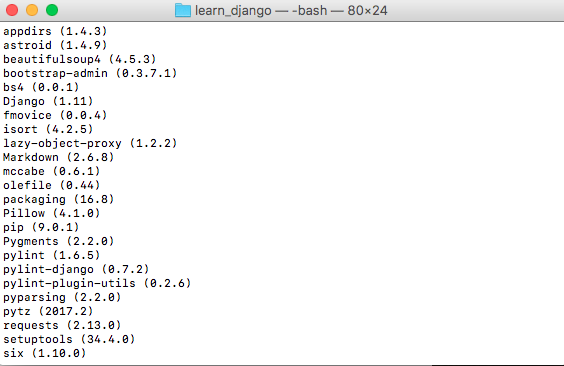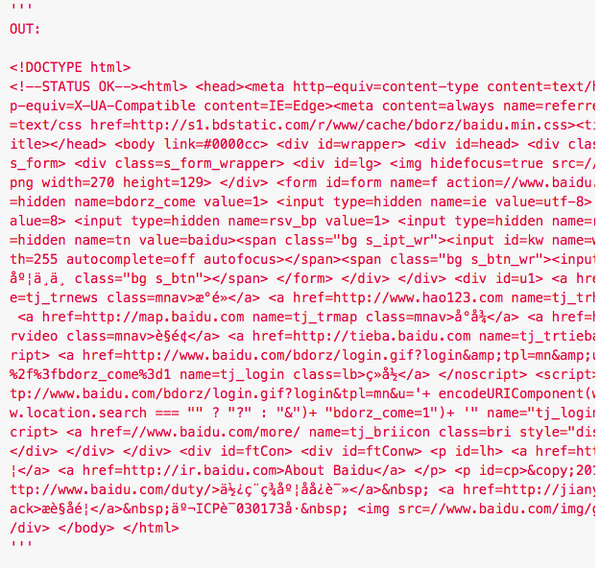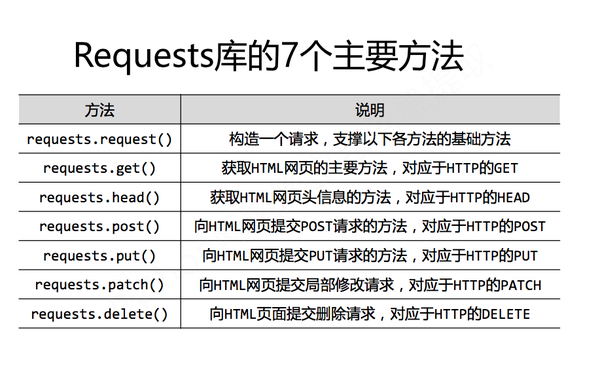从零开始写Python爬虫 --- 1.1 requests库的安装与使用
来源:互联网 发布:淘宝人群标签 编辑:程序博客网 时间:2024/06/03 23:43
从零开始写Python爬虫 --- 1.1 requests库的安装与使用
先来说说爬虫的原理:爬虫本质上是模拟人浏览信息的过程,只不过他通过计算机来达到快速抓取筛选信息的目的。所以我们想要写一个爬虫,最基本的就是要将我们需要抓取信息的网页原原本本的抓取下来。这个时候就要用到requests库了。
- requests库的安装
requests库本质上就是模拟了我们用浏览器打开一个网页,发起请求是的动作。它能够迅速的把请求的html源文件保存到本地
他安装的方式非常简单:我们用pip工具在命令行里进行安装
$ pip install requests`接着我们看一下是否成功安装了bs4库
$ pip list看一下安装结果
- requests库的基本使用:
#首先我们先导入requests这个包import requests#我们来吧百度的index页面的html源码抓取到本地,并用r变量保存#注意这里,网页前面的 http://一定要写出来,它并不能像真正的浏览器一样帮我们补全http协议r = requests.get("http://www.baidu.com")#将下载到的内容打印一下:print(r.text)可以看到,百度的首页源码文件我们已经把他抓取到本地了。
上面的抓取过程中,我们用到了requests库的get方法,
这个方法是requests库中最常用的方法之一。
他接受一个参数(url)并返回一个HTTP response对象。
与get方法相同的,requests库还有许多其他常用方法:
- 下面我们来详细了解一下 requests.get 这个方法:
#这个方法可以接收三个参数,其中第二个默认为None 第三个可选def get(url, params=None, **kwargs)#作用是模拟发起GET请求Sends a GET request.#模拟获取页面的url链接:param url: URL for the new :class:Request object. #额外参数 字典或字节流格式,可选:param params: (optional) Dictionary or bytes to be sent in the query string for the :class:Request. # 十二个控制访问参数,比如可以自定义header:param **kwargs: Optional arguments that request takes. # 返回一个Response对象:return: :class:Response <Response> object :type: requests.Response- 我们来着重讲一下 **kwargs 这个参数
kwargs: 控制访问的参数,均为可选项
params : 字典或字节序列,作为参数增加到url中
data : 字典、字节序列或文件对象,作为Request的内容 json : JSON格式的数据,作为Request的内容
headers : 字典,HTTP定制头
cookies : 字典或CookieJar,Request中的cookie
auth : 元组,支持HTTP认证功能
files : 字典类型,传输文件
timeout : 设定超时时间,秒为单位
proxies : 字典类型,设定访问代理服务器,可以增加登录认证
allow_redirects : True/False,默认为True,重定向开关
stream : True/False,默认为True,获取内容立即下载开关
verify : True/False,默认为True,认证SSL证书开关
cert : 本地SSL证书路径
url: 拟更新页面的url链接
data: 字典、字节序列或文件,Request的内容
json: JSON格式的数据,Request的内容
常用的两个控制访问参数:
1. 假设我们需要在GET请求里自定义一个header头文件:
import requestshd = {'User-agent':'123'}r = requests.get('http://www.baidu.com', headers=hd)print(r.request.headers)'''OUT:{'User-agent': '123', 'Accept-Encoding': 'gzip, deflate', 'Accept': '*/*', 'Connection': 'keep-alive'}'''2. 假设我们要自定义一个代理池
pxs = { 'http': 'http://user:pass@10.10.10.1:1234', 'https': 'https://10.10.10.1:4321' }r = requests.get('http://www.baidu.com', proxies=pxs)- 详细了解Response对象
import requestsr = requests.get("http://www.baidu.com")'''Response(self)The :class:Response <Response> object, which contains a server's response to an HTTP request.'''#HTTP请求的返回状态,比如,200表示成功,404表示失败print (r.status_code)#HTTP请求中的headersprint (r.headers)#从header中猜测的响应的内容编码方式 print (r.encoding)#从内容中分析的编码方式(慢)print (r.apparent_encoding)#响应内容的二进制形式print (r.content)'''status_code:200 headers:{'Server': 'bfe/1.0.8.18', 'Date': 'Tue, 02 May 2017 12:01:47 GMT', 'Content-Type': 'text/html', 'Last-Modified': 'Mon, 23 Jan 2017 13:28:27 GMT', 'Transfer-Encoding': 'chunked', 'Connection': 'Keep-Alive', 'Cache-Control': 'private, no-cache, no-store, proxy-revalidate, no-transform', 'Pragma': 'no-cache', 'Set-Cookie': 'BDORZ=27315; max-age=86400; domain=.baidu.com; path=/', 'Content-Encoding':'gzip'}encoding: ISO-8859-1apparent_encoding:utf-8'''- requests抓取网页的通用框架
import requestsdef getHtmlText(url): try: r = requests.get(url, timeout=30) # 如果状态码不是200 则应发HTTOError异常 r.raise_for_status() # 设置正确的编码方式 r.encoding = r.apparent_encoding return r.text except: return "Something Wrong!"好了关于requests库我们今天就写到这,这是一个非常强大的库,
更多的功能大家可以去看一下官方的文档:快速上手 - Requests 2.10.0 文档
每天的学习记录都会 同步更新到:
微信公众号: findyourownway
知乎专栏:从零开始写Python爬虫 - 知乎专栏
blog : Ehco Blog
- 从零开始写Python爬虫 --- 1.1 requests库的安装与使用
- Python从零开始写爬虫(一)requests库使用
- 从零开始写Python爬虫 --- 1.2 BS4库的安装与使用
- 从零开始写Python爬虫 --- 2.1 Scrapy 爬虫框架的安装与基本介绍
- Python利用Requests库写爬虫
- Python从零开始写爬虫(二)BeautifulSoup库使用
- python爬虫(requests)库安装
- 从零开始写Python爬虫 --- 1.3 BS4库的解析器
- python爬虫-Requests库
- Python爬虫 --requests库
- Python利用Requests库写爬虫(一)
- Python利用Requests库写爬虫(一)
- python网络爬虫1.1requests库
- Python 网络爬虫与信息获取(一)—— requests 库的网络爬虫
- Python从零开始(库的安装与初步使用1)
- Python从零开始(库的安装与初步使用2)
- 从零开始学网络爬虫之Requests库
- 从零开始写Python爬虫 --- 导言
- [poj2524]Ubiquitous Religions
- Rxjava2.x很详细的介绍
- [BZOJ2326][HNOI2011]数学作业(矩乘)
- js归并排序
- POJ 2051 Argus
- 从零开始写Python爬虫 --- 1.1 requests库的安装与使用
- Bootstrap初步了解 起步 基本模板
- [LintCode]175.翻转二叉树
- js封装cookie函数
- 通过行为参数传递代码
- 常用正则表达式
- 从零开始写Python爬虫 --- 导言
- Anniversary party POJ
- js实现上传图片并预览





